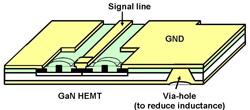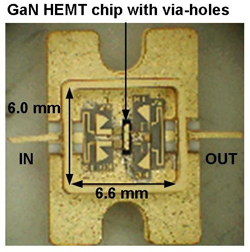
| Home | About Us | Contribute | Bookstore | Advertising | Subscribe for Free NOW! |
| News Archive | Features | Events | Recruitment | Directory |
| FREE subscription |
| Subscribe for free to receive each issue of Semiconductor Today magazine and weekly news brief. |
News
4 November 2008
Fujitsu reports record-performance 5GHz-bandwidth hybrid amplifier
At the 2008 IEEE Compound Semiconductor IC Symposium (CSICS) in Monterey, CA, USA last month, Fujitsu Laboratories Ltd of Kawasaki, Japan detailed its development of a high-performance power amplifier based on gallium nitride high-electron-mobility transistors (HEMTs) which, as a hybrid amplifier (with the transistor and capacitor each mounted on separate package substrates), has what is claimed to be record output performance in terms of power and efficiency at C- to X-band radio frequency bandwidths above 5GHz.
Fujitsu says that the technology opens up the potential for higher performance and functionality in broadband and radar communication systems, in particular for airplane radar systems and other instruments that use multiple frequencies, which could be accommodated by a single amplifier. Also, compared with conventional power amplifiers that use gallium arsenide, the new ultra-wideband (UWB) GaN HEMT-based amplifier features higher efficiency (the proportion of direct-current input power converted to high-frequency output power), enabling a reduction in the size of cooling equipment (which should result in smaller and lighter power amplifiers).
Fujitsu says that, to expand radar detection ranges and the distance that radio waves in wireless communications can travel, it is necessary to increase the output power of transmitters. In addition, to increase transmission capacities and heighten the detection performance of radar that detects multiple targets, it is necessary to expand the bandwidth of transmitters and enable them to handle multiple channels. Airplane radar systems need to use two different types of transmitters so that they can switch back and forth between the C-band (4-8GHz, which is relatively impervious to the effect of atmospheric precipitation) and the X-band (8-12GHz, which enables high-resolution measurement). If a transmitter could handle ultra-wideband frequencies spanning from the C-band to the X-band, then just one transmitter would suffice, allowing systems to be more compact.
Conventionally, wideband high-output amplifiers have used GaAs transistors. But, to generate sufficient transmission output, the output of many GaAs transistors needs to be combined, reducing efficiency as a result of losses in the matching circuits (which equalize an output circuit's load with the receiving-side circuit's input load, to maximize the power generated in an electrical signal transmission path). So, recent years have seen a surge in efforts to develop GaN-based HEMT amplifiers, which have a larger dielectric breakdown field and the potential to generate higher output levels.
Monolithic microwave integrated circuits (MMICs) - which include a transistor, capacitor, resistor, and circuit interconnects mounted on the same substrate - enable wideband characteristics at high frequencies such as the C- and X-band ranges. However, due to the problems of using GaAs transistors, MMICs using GaAs have been unable to deliver sufficient levels of output and efficiency.
On the other hand, in trying to apply MMIC technology to GaN HEMTs with high operating voltages, the breakdown voltage of the chip capacitor has been insufficient. By using a hybrid integrated circuit instead, in which the transistor and capacitor are mounted separately, the impedance problem is eliminated because a high-breakdown voltage-capacitor can be used. However, as wires used in the signal line connections or ground connections reduce the amplification factor of high-frequency signals (increasing frequency variance), up to now it has been difficult to generate high efficiency in a wide bandwidth.

Figure 1: Diagram of GaN HEMT chip with via-holes.
Fujitsu says that its C- to X-band hybrid GaN HEMT power amplifier resolves these issues. Key features of the technology include the following:
- Although wires used in ground connections reduce the amplification factor of high-frequency signals used in the C- to X-band range, in the new hybrid circuit a transistor with via holes that connect the GaN HEMT chip's surface electrode with the bottom electrode (Figure 1) is used, eliminating the need for ground connection wires and suppressing the reduction in the amplification factor of high-frequency signals.
- To suppress the frequency variance caused by wires used in the signal line connection, a UWB matching circuit was developed. Also, by using a high-breakdown-voltage capacitor in the matching circuit, high output power was achieved at high operating voltages.
 Fujitsu says that these technologies enabled the generation of both high output power and high efficiency at high frequencies across wide bandwidth. In addition, despite being a hybrid power amplifier, the new amplifier is compact, measuring just 6.0mm x 6.6mm (Figure 2).
Fujitsu says that these technologies enabled the generation of both high output power and high efficiency at high frequencies across wide bandwidth. In addition, despite being a hybrid power amplifier, the new amplifier is compact, measuring just 6.0mm x 6.6mm (Figure 2).
Figure 2: Newly developed C- to X-band power amplifier.
 The new UWB hybrid C- to X-band power amplifier achieved output of 6.5W and efficiency of 40% at a frequency of 7GHz, and output of 4.1W and efficiency of 26% at 12GHz. Fujitsu claims that this significantly exceeds previously reported performance for UWB GaN-based high-output hybrid amplifiers (see Figure 3).
The new UWB hybrid C- to X-band power amplifier achieved output of 6.5W and efficiency of 40% at a frequency of 7GHz, and output of 4.1W and efficiency of 26% at 12GHz. Fujitsu claims that this significantly exceeds previously reported performance for UWB GaN-based high-output hybrid amplifiers (see Figure 3).
Figure 3: Efficiency comparison of UWB GaN-hybrid C- to X-band power amplifiers.
The firm reckons that the technology enables transmitters to handle multiple channels and allows the use of multiple frequencies with differing characteristics, boosting performance and functionality in systems for applications such as broadband communications and radar. The technology can also be used in measuring instruments, for which output at high frequencies had been insufficient, in order to measure the performance of amplifiers used in such systems. Moreover, because the new GaN-HEMT-based amplifiers are more efficient than amplifiers using GaAs, it should be possible to reduce the size and weight of the box housing the amplifier and cooling system.
Fujitsu plans to apply the technology widely in areas requiring high-output broadband performance, such as wireless communications equipment and radar systems.
See related items:
Fujitsu reports record 320W C-band power amplifiers
Fujitsu claims first high-output GaN HEMT to cut power in standby mode
Fujitsu develops first impulse radio transmitting at over 10Gb/s in millimeter band
Fujitsu’s GaN HEMT-based mobile WiMAX base-station chosen by UQ
Fujitsu launches GaN HEMT-based mobile WiMAX base-stations
Visit: http://jp.fujitsu.com/group/labs/en